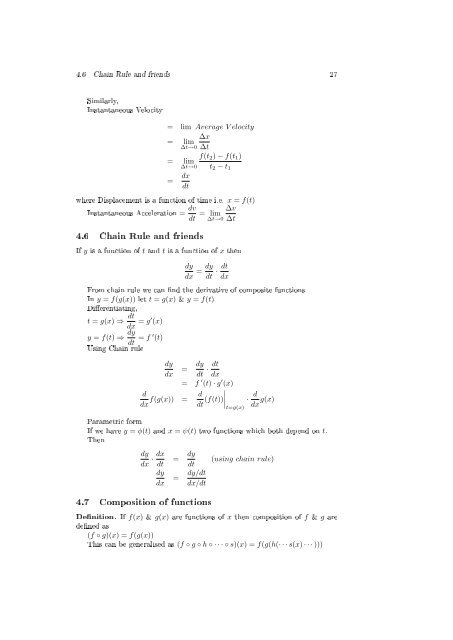Denition approach of learning new topics
Create successful ePaper yourself
Turn your PDF publications into a flip-book with our unique Google optimized e-Paper software.
4.6 Chain Rule and friends 27<br />
Similarly,<br />
Instantaneous Velocity<br />
= lim Average V elocity<br />
∆x<br />
= lim<br />
∆t→0 ∆t<br />
f(t 2 ) − f(t 1 )<br />
= lim<br />
∆t→0 t 2 − t 1<br />
= dx<br />
dt<br />
where Displacement is a function <strong>of</strong> time i.e. x = f(t)<br />
Instantaneous Acceleration = dv<br />
dt = lim ∆v<br />
∆t→0 ∆t<br />
4.6 Chain Rule and friends<br />
If y is a function <strong>of</strong> t and t is a function <strong>of</strong> x then<br />
dy<br />
dx = dy<br />
dt · dt<br />
dx<br />
From chain rule we can nd the derivative <strong>of</strong> composite functions<br />
In y = f(g(x)) let t = g(x) & y = f(t)<br />
Dierentiating,<br />
t = g(x) ⇒ dt<br />
dx = g′ (x)<br />
y = f(t) ⇒ dy<br />
dt = f ′ (t)<br />
Using Chain rule<br />
dy<br />
dx = dy<br />
dt · dt<br />
dx<br />
= f ′ (t) · g ′ (x)<br />
d<br />
dx f(g(x)) = d ∣<br />
∣∣∣t=g(x)<br />
dt (f(t)) d<br />
·<br />
dx g(x)<br />
Parametric form<br />
If we have y = φ(t) and x = ψ(t) two functions which both depend on t.<br />
Then<br />
dy<br />
dx · dx<br />
dt<br />
= dy<br />
dt<br />
dy<br />
dx = dy/dt<br />
dx/dt<br />
4.7 Composition <strong>of</strong> functions<br />
(using chain rule)<br />
<strong>Denition</strong>. If f(x) & g(x) are functions <strong>of</strong> x then composition <strong>of</strong> f & g are<br />
dened as<br />
(f ◦ g)(x) = f(g(x))<br />
This can be generalised as (f ◦ g ◦ h ◦ · · · ◦ s)(x) = f(g(h(· · · s(x) · · · )))



